A Novel Excitation Approach for Power Transformer Simulation Based on Finite Element Analysis
Abstract
:1. Introduction
2. 2D Finite Element Analysis Model
2.1. ANSYS Maxwell Solver Equation
- B: magnetic flux density (T);
- H: magnetic field intensity (A/m);
- E: electric field (V/m);
- D: electric displacement (C/m2);
- J: conduction-current density (A/m2);
- : charge density (C/m2).
2.2. Core Loss Model
- Bm: magnetic flux density of the iron core;
- f0: operating frequency of the transformer;
- kh: coefficient of the hysteresis loss;
- kc: coefficient of the eddy current loss coefficient;
- ke: coefficient of the excessive loss.
- Pvi: i-th iron loss of the P-B loss curve in the iron core;
- Bvi: i-th magnetic flux density of the P-B loss curve in the iron core.
2.3. External Excitation
- The external exciting voltage Vin is the ideal voltage source;
- Parallel resistance Rp is bigger than the magnetizing reactance XLm;
- The turns ratio is defined as N = N1/N2;
- The secondary side circuit is open;
- The external excitation voltages are balanced in three phases.
2.4. 2D Model Depth
3. Finite Element Analysis Simulation
3.1. Simulation Model
3.2. External Excitation Parameters
3.3. Simulation Results
4. Experimental Results
5. Conclusions
Author Contributions
Funding
Institutional Review Board Statement
Informed Consent Statement
Data Availability Statement
Acknowledgments
Conflicts of Interest
References
- Orosz, T. Evolution and Modern Approaches of the Power Transformer Cost Optimization Methods. Period. Polytech. Electr. Eng. Comput. Sci. 2019, 63, 37–50. [Google Scholar] [CrossRef] [Green Version]
- Orosz, T.; Sleisz, Á.; Tamus, Z.Á. Metaheuristic Optimization Preliminary Design Process of Core-Form Autotransformers. IEEE Tran. Magn. 2016, 52, 1–10. [Google Scholar] [CrossRef]
- Loizos, G.; Kefalas, T.D.; Kladas, A.G.; Souflaris, A.T. Flux Distribution Analysis in Three-Phase Si-Fe Wound Transformer Cores. IEEE Tran. Magn. 2010, 46, 594–597. [Google Scholar] [CrossRef]
- Li, L.; Du, X.; Pan, J.; Keating, A.; Matthews, D.; Huang, H.; Zheng, J. Distributed Magnetic Flux Density on the Cross-Section of a Transformer Core. Electronics 2019, 8, 297. [Google Scholar] [CrossRef] [Green Version]
- Mohammed, M.S.; Vural, R.A. NSGA-II+FEM Based Loss Optimization of Three-Phase Transformer. IEEE Trans. Ind. Electron. 2019, 66, 7417–7425. [Google Scholar] [CrossRef]
- Orosz, T.; Pánek, D.; Karban, P. FEM Based Preliminary Design Optimization in Case of Large Power Transformers. Appl. Sci. 2020, 10, 1361. [Google Scholar] [CrossRef] [Green Version]
- Nicolae, P.M.; Constantin, D.; NITU, M.C. 2D Electromagnetic Transient and Thermal Modeling of a Three-Phase Power Transformer. In Proceedings of the 2013 4th International Youth Conference on Energy (IYCE), Siófok, Hungary, 6–8 June 2013; pp. 1–5. [Google Scholar] [CrossRef]
- Biro, O.; Buchgraber, G.; Leber, G.; Preis, K. Prediction of Magnetizing Current Wave-Forms in a Three-Phase Power Transformer Under DC Bias. IEEE Tran. Magn. 2008, 44, 1554–1557. [Google Scholar] [CrossRef]
- Gong, R.; Ruan, J.; Chen, J.; Quan, Y.; Wang, J.; Jin, S. A 3-D Coupled Magneto-Fluid-Thermal Analysis of a 220 kV Three-Phase Three-Limb Transformer under DC Bias. Energies 2017, 10, 422. [Google Scholar] [CrossRef]
- Xia, D. The Distribution of Transient Magnetic Field and Eddy Current Losses of Three-Phase Five-Legged Transformer under DC Bias. In Proceedings of the 2018 IEEE International Conference on Internet of Things (iThings) and IEEE Green Computing and Communications (GreenCom) and IEEE Cyber, Physical and Social Computing (CPSCom) and IEEE Smart Data (SmartData), Halifax, NS, Canada, 30 July 2018; pp. 728–732. [Google Scholar] [CrossRef]
- Smajic, J.; Steinmetz, T.; Cretu, B.C.; Nogues, A.; Murillo, R.; Tepper, J. Analysis of Near and Far Stray Magnetic Fields of Dry-Type Transformers: 3-D Simulations Versus Measurements. IEEE Tran. Magn. 2011, 47, 1374–1377. [Google Scholar] [CrossRef]
- Moghaddami, M.; Sarwat, A.I.; Leon, F.D. Reduction of Stray Loss in Power Transformers Using Horizontal Magnetic Wall Shunts. IEEE Tran. Magn. 2017, 53, 1374–1377. [Google Scholar] [CrossRef]
- Park, K.H.; Lee, H.J.; Hahn, S.C. Finite-Element Modeling and Experimental Verification of Stray-Loss Reduction in Power Transformer Tank with Wall Shunt. IEEE Tran. Magn. 2019, 55, 1–4. [Google Scholar] [CrossRef]
- Khan, S.; Maximov, S.; Escarela-Perez, R.; Olivares-Galvan, J.C.; Melgoza-Vazquez, E.; Lopez-Garcia, I. Computation of Stray Losses in Transformer Bushing Regions Considering Harmonics in the Load Current. Appl. Sci. 2020, 10, 3527. [Google Scholar] [CrossRef]
- Bastiaens, K.; Curti, M.; Krop, D.C.J.; Jumayev, S.; Lomonova, E.A. Spectral Element Method Modeling of Eddy Current Losses in High-Frequency Transformers. Math. Comput. Appl. 2019, 24, 28. [Google Scholar] [CrossRef] [Green Version]
- Bal, S.; Demirdelen, T.; Tümay, M. Three-Phase Distribution Transformer Modeling and Electromagnetic Transient Analysis Using ANSYS Maxwell. In Proceedings of the 2019 3rd International Symposium on Multidisciplinary Studies and Innovative Technologies (ISMSIT), Ankara, Turkey, 11–13 October 2019. [Google Scholar] [CrossRef]


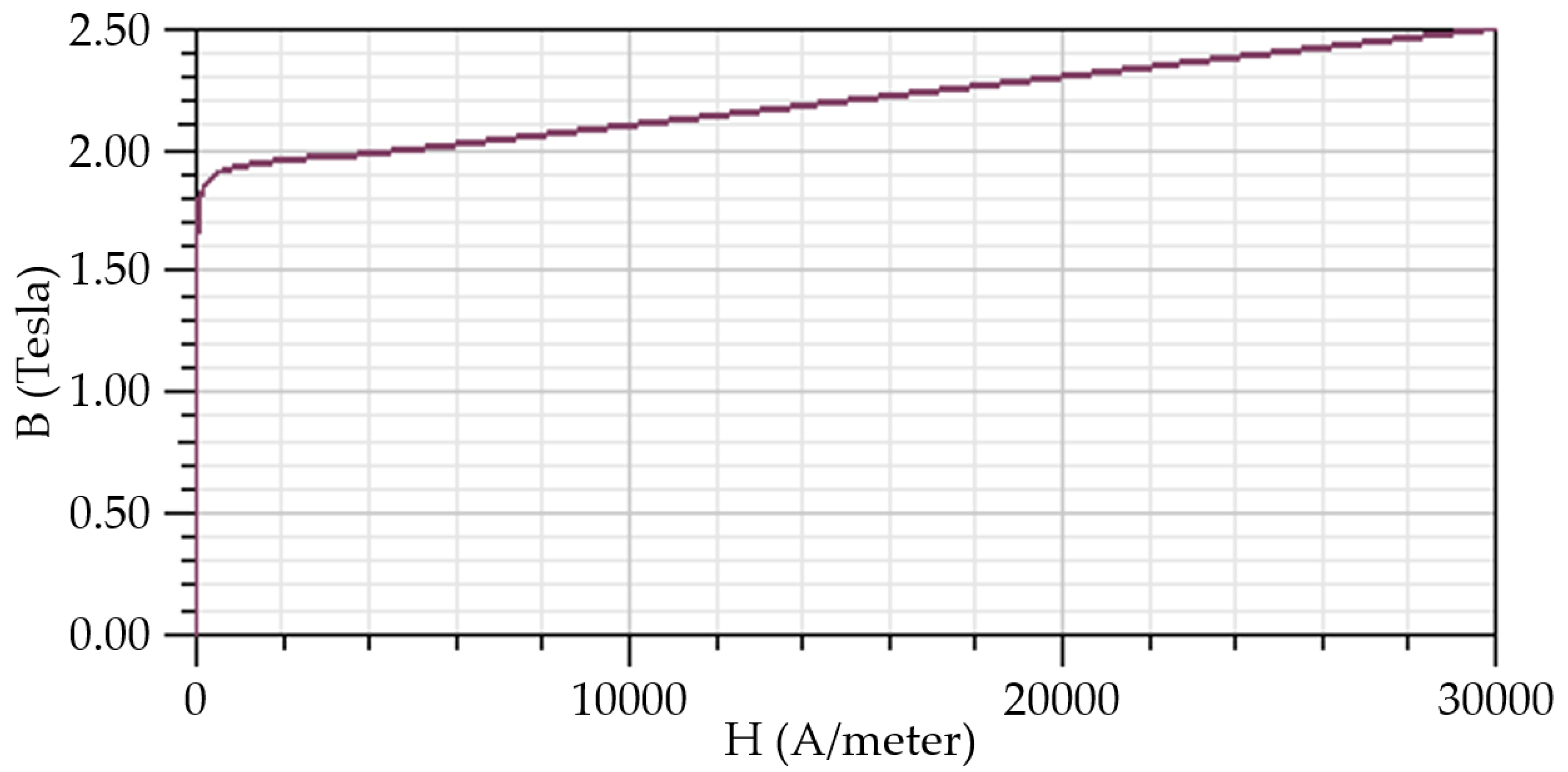
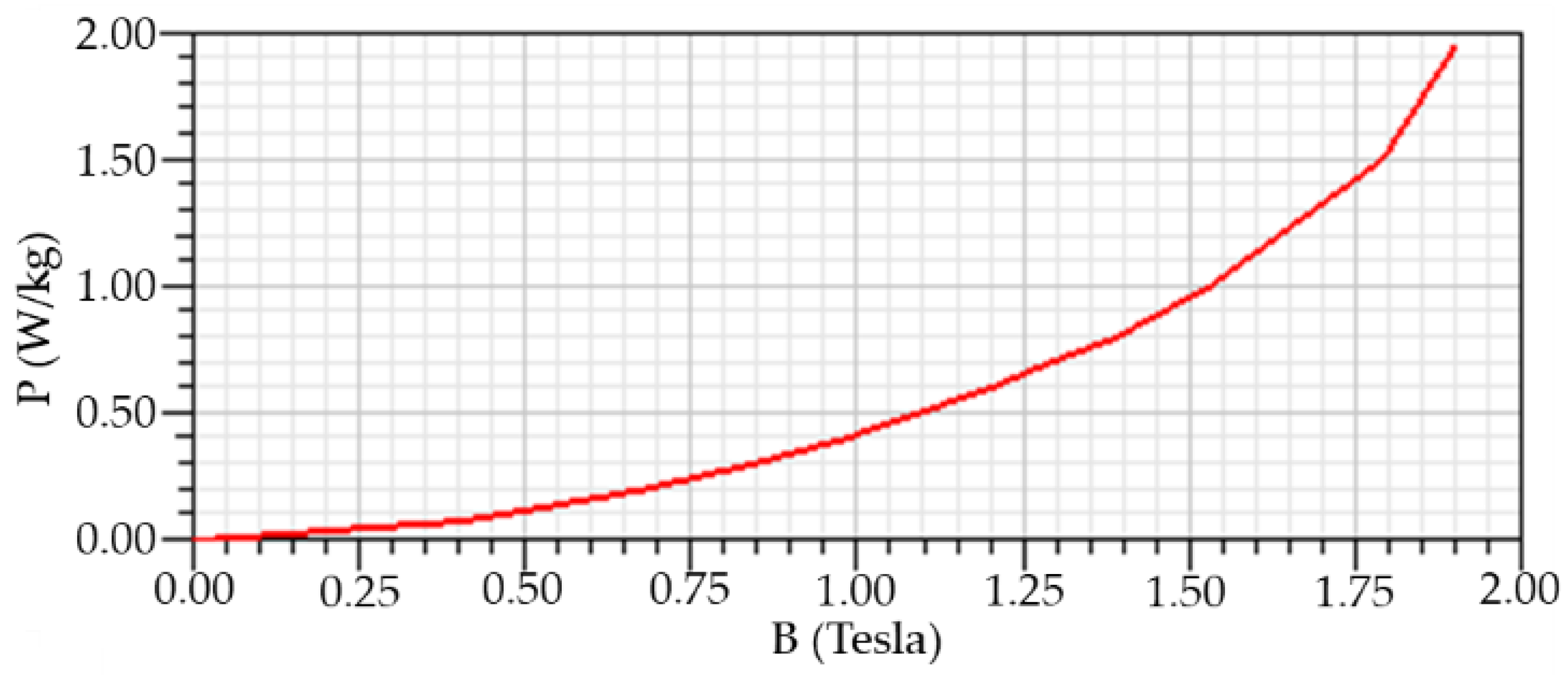


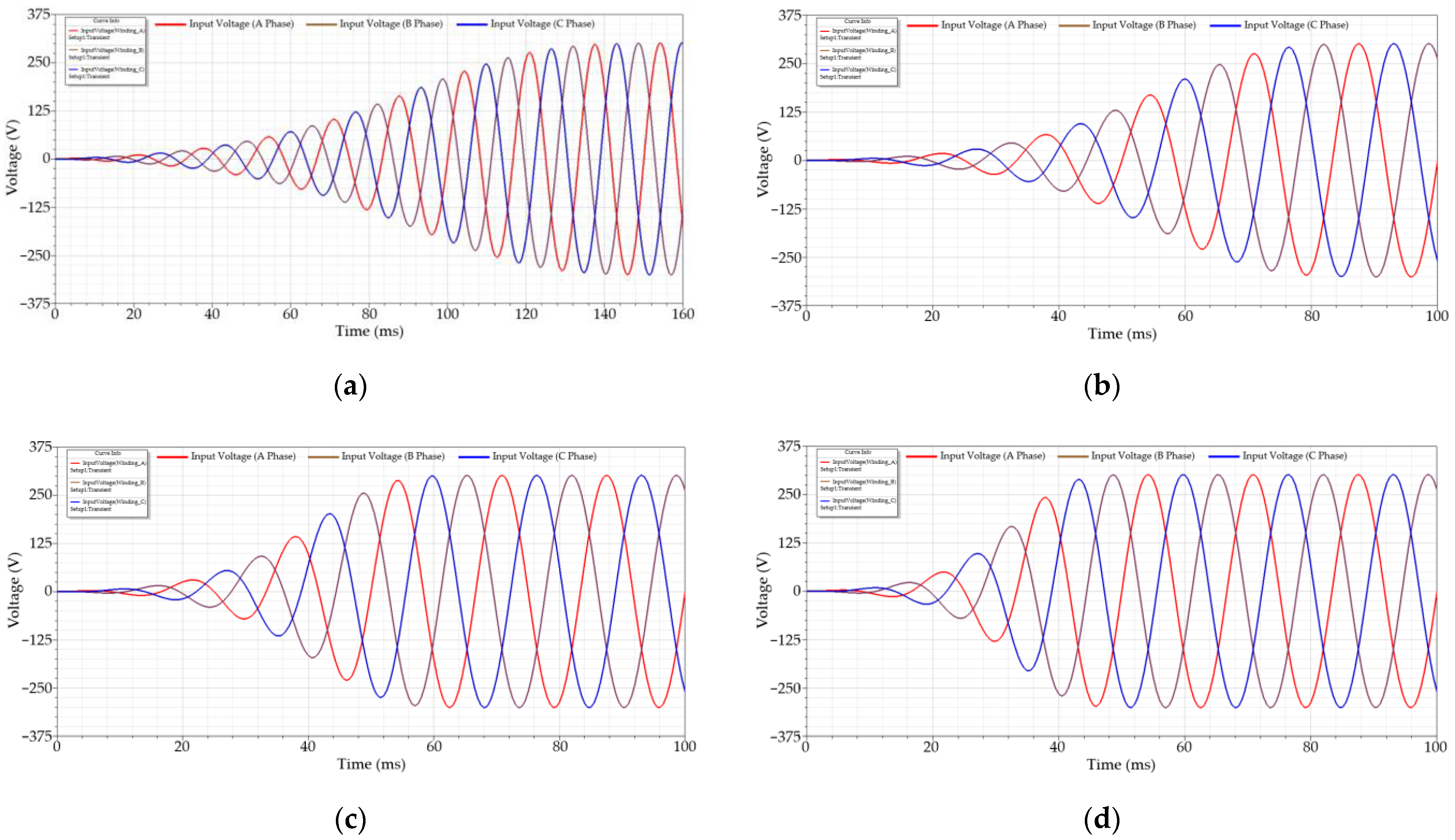
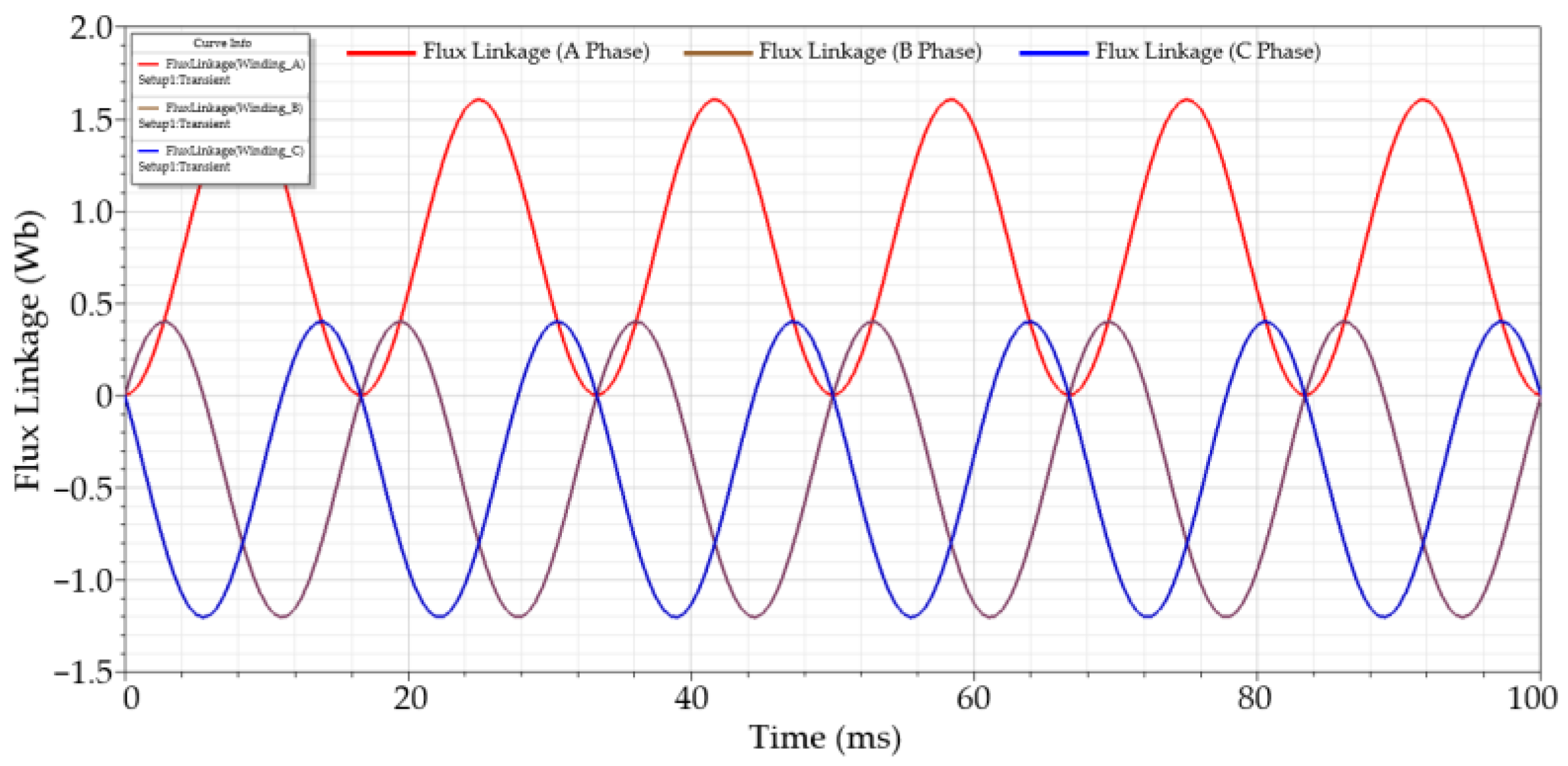

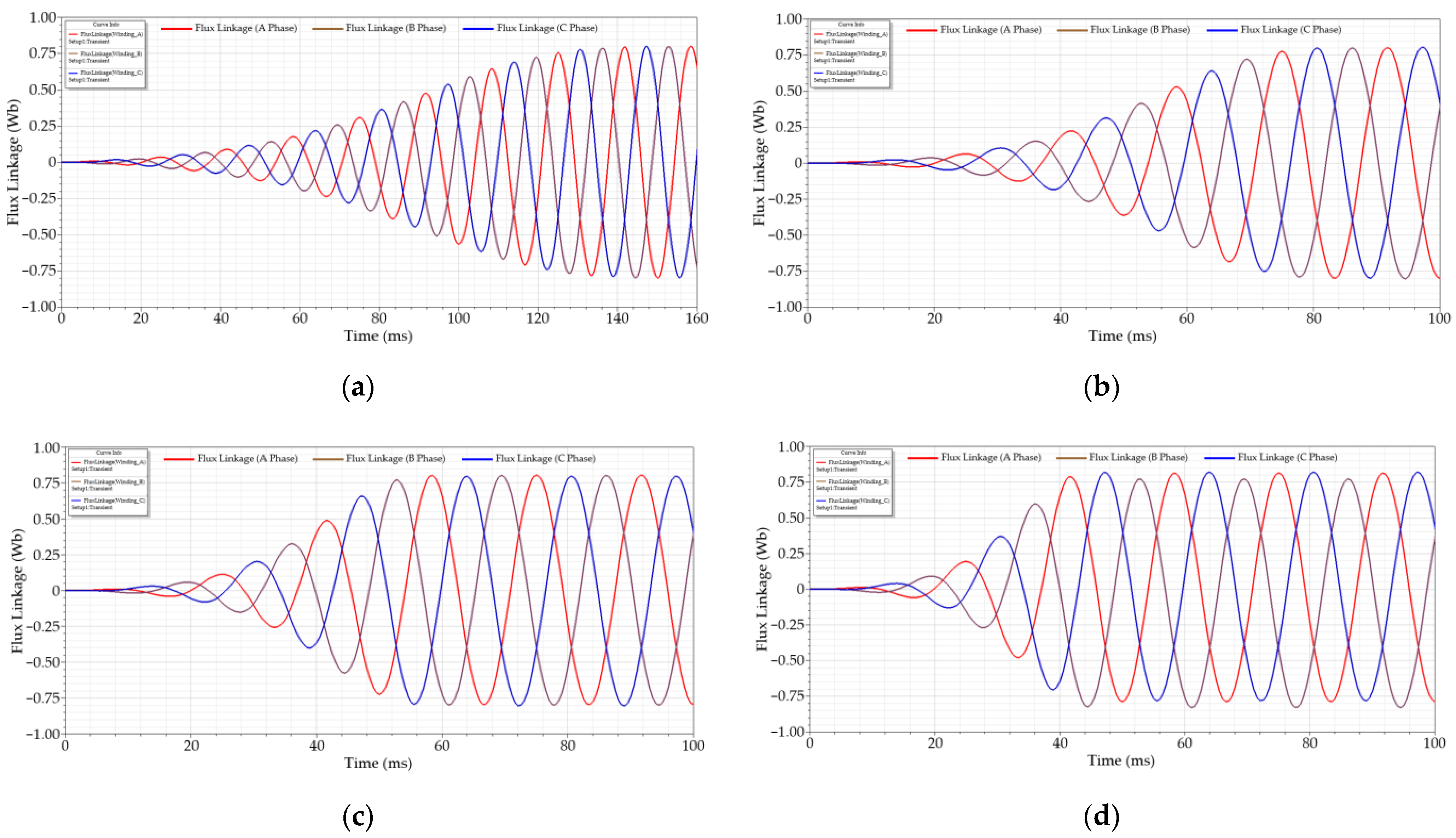




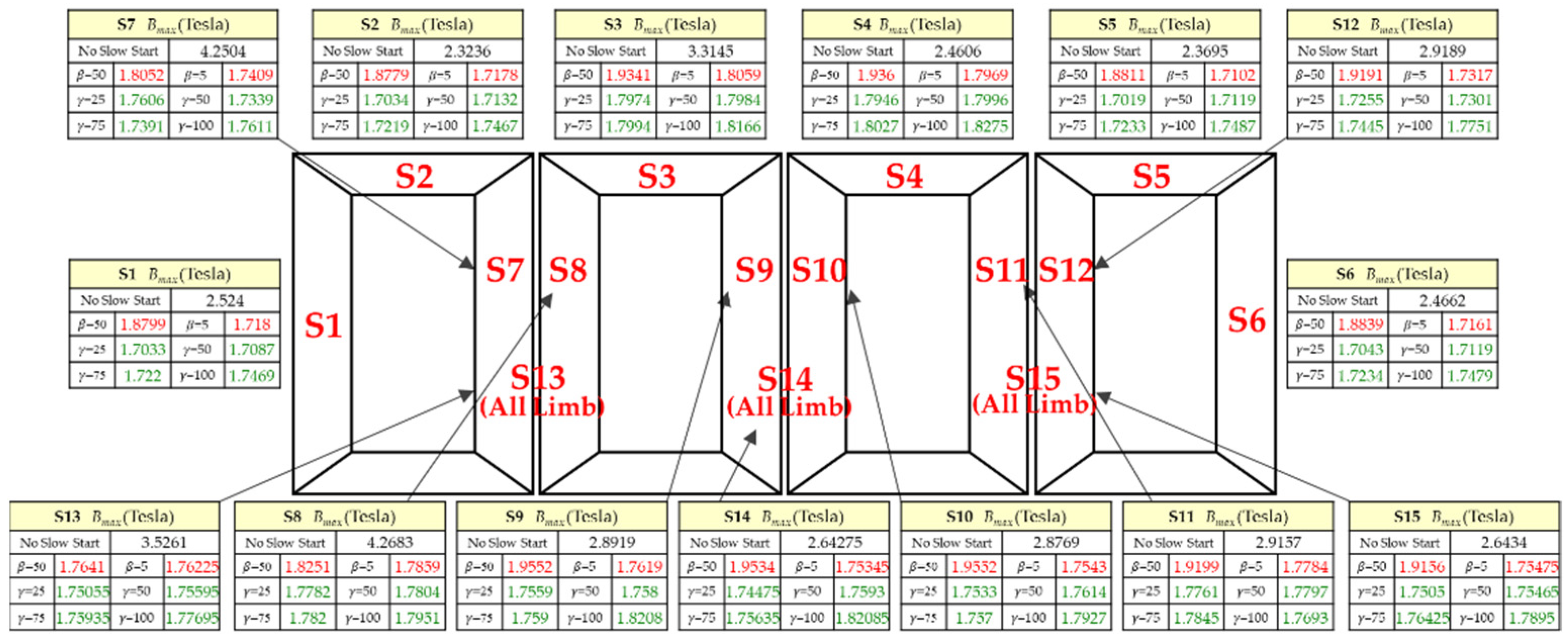

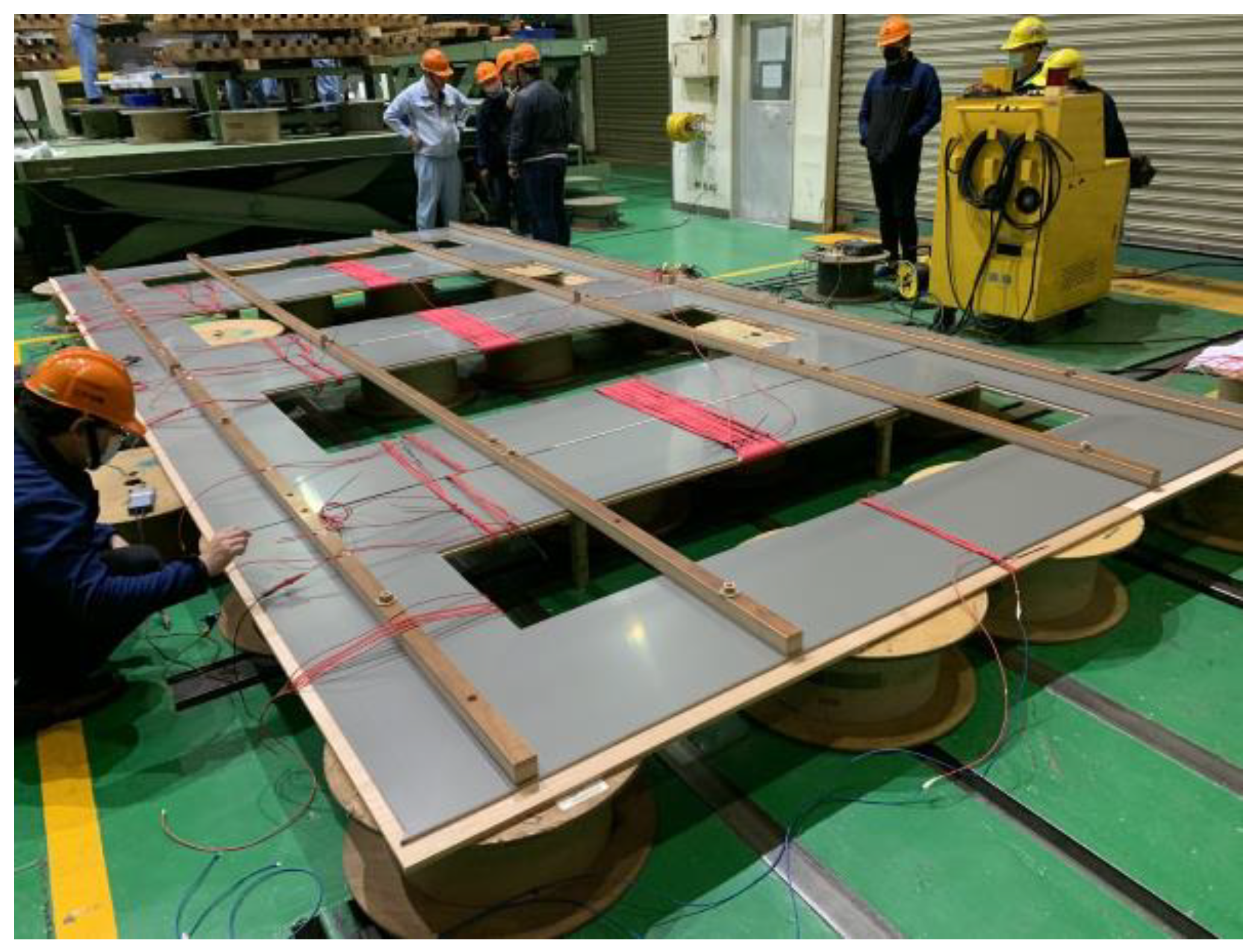
| Name | Parameter |
|---|---|
| Length of Single Limb | 480 mm |
| Depth of 2D Model | 10.3354 mm |
| Name | Material | Parameter |
|---|---|---|
| Excitation Coil | Copper | Resistivity: 1.68 × 10−8 [Ω m] |
| Iron Core | Electrical Grade Sheet | Conductivity: 2,083,300 [S/m] Mass Density: 7650 [kg/m3] Relative Permeability: Non-linear B-H Curve |
| Gap, Environment | Air | Magnetic of Relative Permeability: 1.0000004 |
| Name | Parameter |
|---|---|
| Coefficient of Hysteresis Loss kh | 0.00581484 W/kg |
| Coefficient of Eddy Current Loss kc | 3.26563 × 10−5 W/kg |
| Coefficient of Excessive Loss ke | 0 W/kg |
| Name | Parameter |
|---|---|
| Peak Voltage (Vpeak) | 301.64 V |
| Frequency () | 60 Hz |
| Slow Start Parameters of Conventional Equation | 5, 50 |
| Slow Start Parameters of Proposed Equation | 25, 50, 75, 100 |
| Name | Core Loss | Hysteresis Loss | Eddy Current Loss |
|---|---|---|---|
| No Slow Start Condition | 2.4093 kW | 76.92% | 23.08% |
| Convention Equation () | 2.0087 kW | 64.43% | 35.57% |
| Convention Equation () | 1.9563 kW | 62.75% | 37.25% |
| Proposed Equation () | 1.9479 kW | 62.30% | 37.70% |
| Proposed Equation () | 1.9345 kW | 61.85% | 38.15% |
| Proposed Equation () | 1.9773 kW | 62.48% | 37.52% |
| Proposed Equation () | 2.0012 kW | 62.91% | 37.09% |
| Name | Measured Value | Simulation Results Error | ||||||
|---|---|---|---|---|---|---|---|---|
| No Slow Start | ||||||||
| S1 | 1.5782 T | 59.92% | 19.11% | 8.47% | 7.92% | 8.26% | 9.11% | 10.68% |
| S2 | 1.5843 T | 46.66% | 18.53% | 8.05% | 7.51% | 8.13% | 8.68% | 10.25% |
| S3 | 1.7072 T | 94.14% | 13.29% | 4.71% | 5.28% | 5.34% | 5.40% | 6.40% |
| S4 | 1.6983 T | 44.88% | 13.99% | 6.08% | 5.67% | 5.96% | 6.14% | 7.60% |
| S5 | 1.5571 T | 52.17% | 20.80% | 10.02% | 9.29% | 9.94% | 10.67% | 12.30% |
| S6 | 1.5263 T | 61.58% | 23.42% | 12.24% | 11.66% | 12.16% | 12.91% | 14.51% |
| S7 | 1.6167 T | 162.90% | 11.65% | 6.21% | 8.90% | 7.24% | 7.57% | 8.93% |
| S8 | 1.7058 T | 150.22% | 6.99% | 3.80% | 4.24% | 4.37% | 4.46% | 5.23% |
| S9 | 1.6957 T | 70.54% | 15.30% | 3.90% | 3.55% | 3.67% | 3.73% | 7.37% |
| S10 | 1.7088 T | 68.35% | 14.41% | 3.34% | 2.60% | 3.07% | 2.82% | 4.90% |
| S11 | 1.6746 T | 74.11% | 14.64% | 6.39% | 6.06% | 6.27% | 6.56% | 5.65% |
| S12 | 1.5928 T | 83.25% | 20.48% | 8.87% | 8.33% | 8.62% | 9.52% | 11.44% |
| S13 | 1.6756 T | 110.43% | 5.28% | 4.00% | 4.47% | 4.79% | 4.99% | 6.04% |
| S14 | 1.6884 T | 56.52% | 15.69% | 4.45% | 3.33% | 4.19% | 4.02% | 7.84% |
| S15 | 1.6595 T | 59.28% | 15.43% | 5.91% | 5.48% | 5.73% | 6.31% | 7.83% |
| Name | Core Loss | Error |
|---|---|---|
| Measured Value | 1.949 kW | 0% |
| Simulation Results (No Slow Start) | 2.4093 kW | 23.61% |
| Simulation Results (Conventional Equation, ) | 1.9545 kW | 0.28% |
| Simulation Results (Conventional Equation, ) | 2.0684 kW | 6.12% |
| Simulation Results (Proposed Equation, = 25) | 1.9479 kW | 0.056% |
| Simulation Results (Proposed Equation, = 50) | 1.9345 kW | 0.743% |
| Simulation Results (Proposed Equation, = 75) | 1.9773 kW | 1.452% |
| Simulation Results (Proposed Equation, = 100) | 2.0012 kW | 2.678% |
Publisher’s Note: MDPI stays neutral with regard to jurisdictional claims in published maps and institutional affiliations. |
© 2021 by the authors. Licensee MDPI, Basel, Switzerland. This article is an open access article distributed under the terms and conditions of the Creative Commons Attribution (CC BY) license (https://creativecommons.org/licenses/by/4.0/).
Share and Cite
Chang, W.-C.; Kuo, C.-C. A Novel Excitation Approach for Power Transformer Simulation Based on Finite Element Analysis. Appl. Sci. 2021, 11, 10334. https://doi.org/10.3390/app112110334
Chang W-C, Kuo C-C. A Novel Excitation Approach for Power Transformer Simulation Based on Finite Element Analysis. Applied Sciences. 2021; 11(21):10334. https://doi.org/10.3390/app112110334
Chicago/Turabian StyleChang, Wen-Ching, and Cheng-Chien Kuo. 2021. "A Novel Excitation Approach for Power Transformer Simulation Based on Finite Element Analysis" Applied Sciences 11, no. 21: 10334. https://doi.org/10.3390/app112110334






